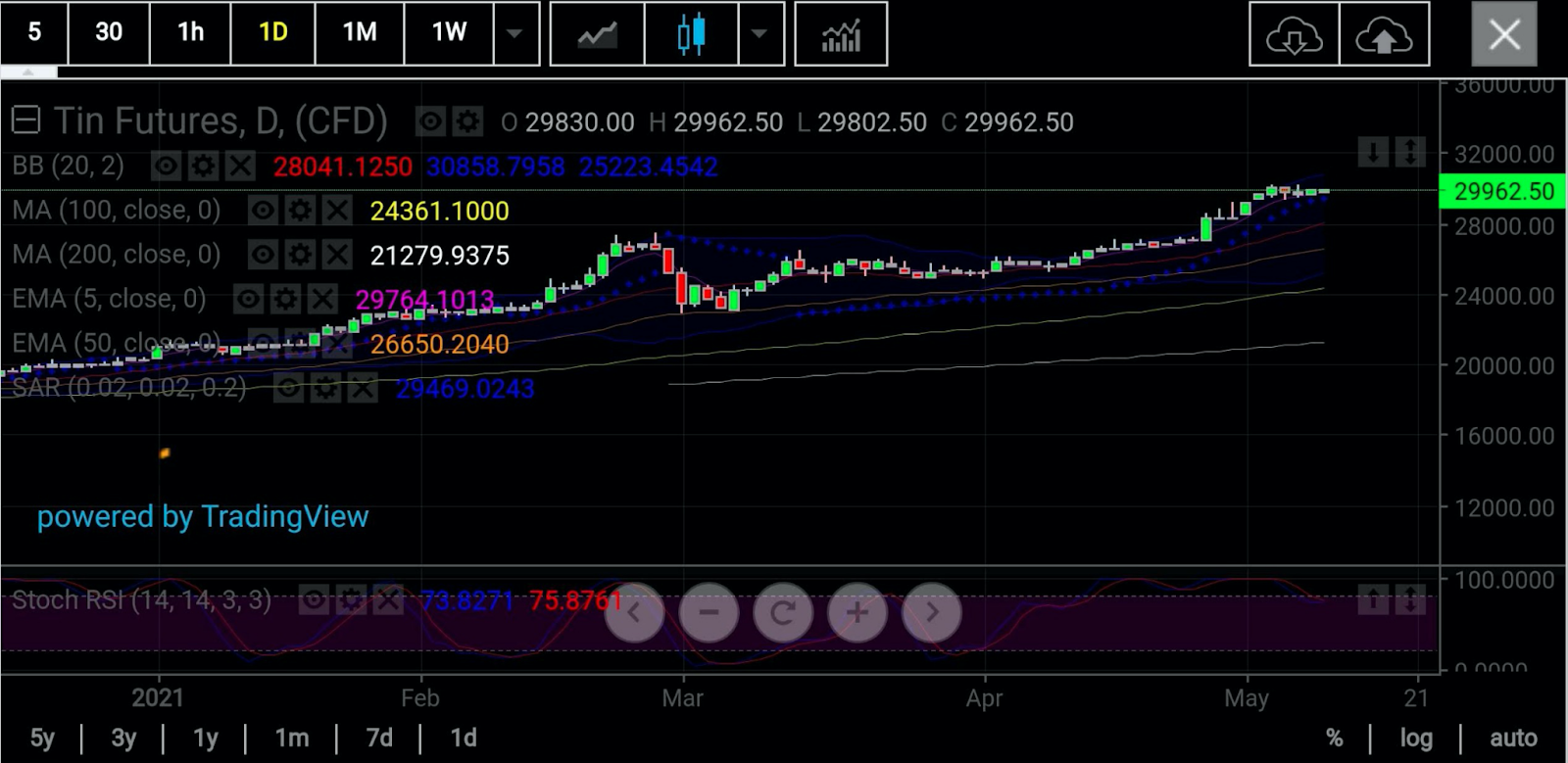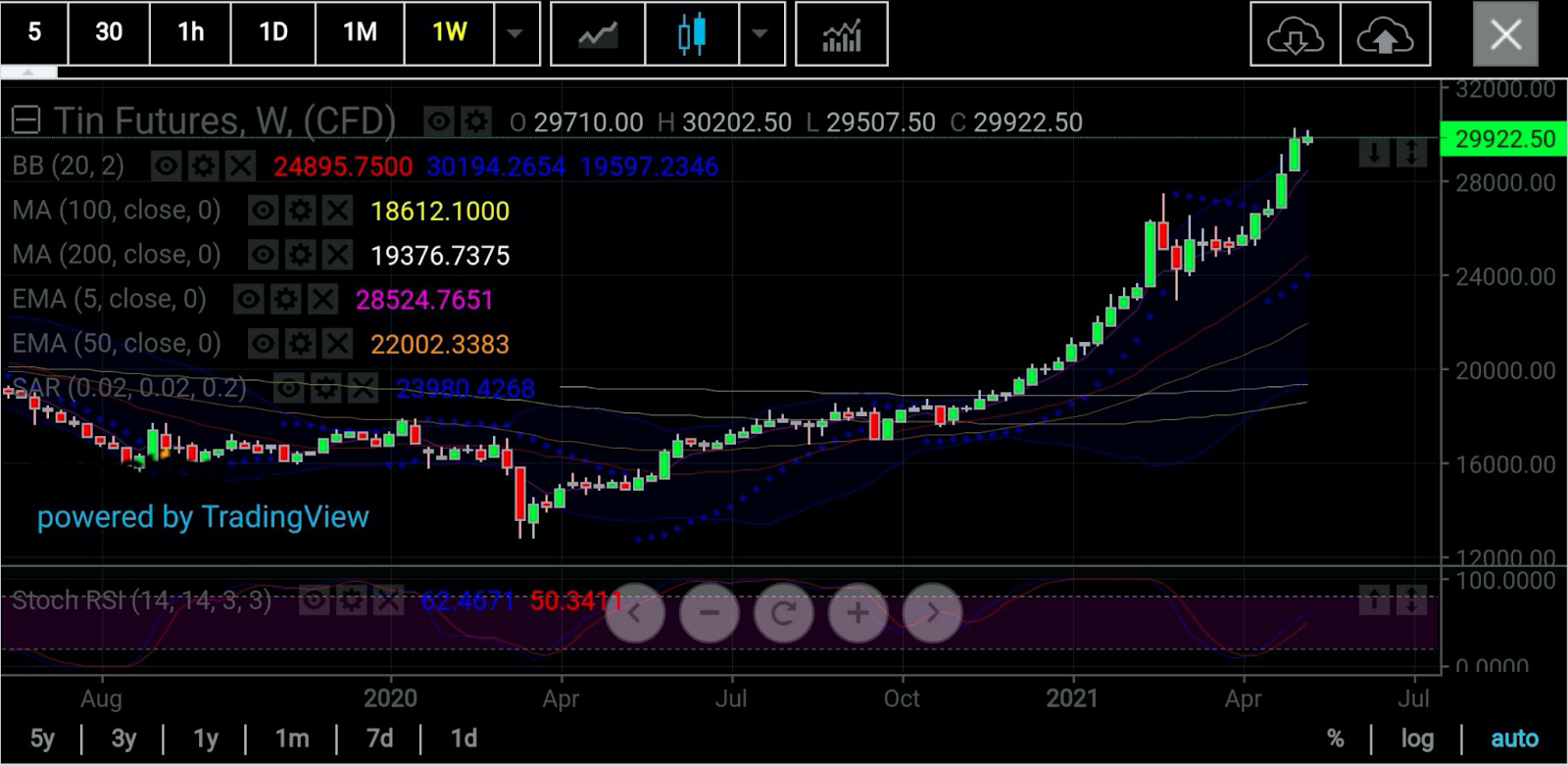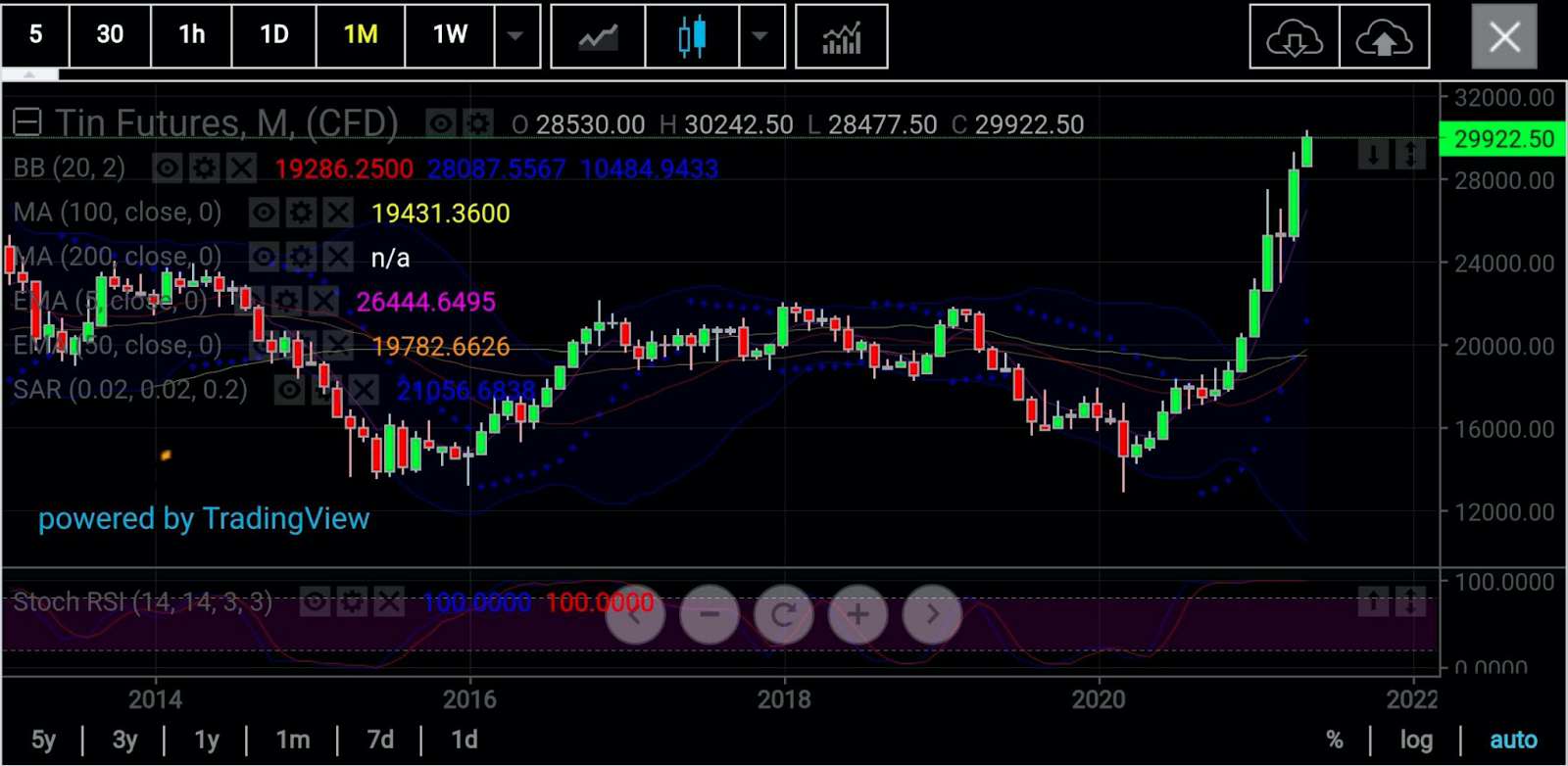The words “tin” and “short squeeze” have become almost inseparable this year as the metal used for soldering and making steel can coverings and foils remains in chronically short supply.
There’s another thing that’s become permanently associated with the commodity since the start of 2021: prices north of $20,000 a tonne.
Three-month tin on the London Metal Exchange hit 10-year highs of almost $30,243 a tonne on May 6, after starting this year at $20,315. That has made it the outperformer of the LME base metals pack, with a gain of 48% on the year.
Based on its present trajectory, tin could continue rallying until it reprises its 2011 record high of $33,500. From there, it may go a little higher, but could also sell-off if commodities are poised for a “serious correction,” as prominent hedge fund manager Cathie Wood of ARK Invest predicts. Chart action for tin also signals exhaustion after a year-long run-up.
The virtually non-stop rally in tin actually began in April 2020—just a month after the global outbreak of COVID-19.
Demand for commodities like tin don’t get a break, even in a pandemic, as for example, people don’t stop buying food in cans.
What breaks down are supply chains for the production and transportation of raw materials as people aren’t able to work because of restrictions. And that disruption combined with continued demand triggers commodity price surges that ultimately feed into higher manufacturing costs and inflation—if passed on to consumers.
Thus, out of the past 14 months, tin prices were only in the negative for two months—August to September.
A Brief History Of Tin’s Use
A silvery, malleable metal, tin’s biggest producers are China, Malaysia, Indonesia, Peru, Thailand, Bolivia and Myanmar.
Alloyed with other metals, tin can be used to produce metals with significantly better qualities than the constituents.
As Thayer Watkins, an economics professor at San Jose State University in California, observed, in ancient times, adding tin to copper in a ratio of about one to ten was found to produce the harder, tougher metal bronze. “Bronze was so important that a significant era in human history was called The Bronze Age,” Watkins writes. “The Bronze Age did not give way to the Iron Age until the supply of tin was cut off for the civilizations of the Eastern Mediterranen.”
The most important modern use of tin is as a protective coating on steel cans for food preservation, creating the ubiquitous tin cans.
An alloy of tin and lead is also used today to make solder for joining together metal parts. An alloy of tin, lead, copper and antimony, called “Babbit metal”, is used for bearings in machines. Printing type is made from an alloy of tin, lead and antimony. Pewter, a metal used for utensils in the past, is an alloy of tin, antimony and copper.
Tin can even be alloyed with iron. Iron with a small proportion (about 0.1 of 1%) of tin is used for automobile engine blocks.
Tin’s malleable and ductile quality also allows it to be used for producing foils. At one time, chewing gum sticks were wrapped in tin foil before being replaced by cheaper aluminum foil. Tin was also used to produce squeezable tubes for pastes, lotions and ointments until being replaced by the cheaper plastic.
Supply Jam And Price Spikes
Cash tin prices are trading around $33,100, a premium of more than $2,850 over the three-month futures contract as warehouses of the London Metal Exchange see continuous inventory drops.
Tightness in the physical supply chain of tin has driven such premiums to record levels in both the United States and Europe, with flows of the metal from Asia disrupted by backlogs in the container shipping sector.
The massive premium for prompt delivery of tin has enticed a trickle of metal into exchange warehouses, but not enough to tame market wildness.
Usually an importer of the metal, China became a net exporter of tin in the last couple of months as it stepped up to supply the world’s shipping lanes, while shipments from Indonesia, the world’s largest exporter, fell 24% in the first quarter of 2021.
As Reuters noted in a mid-March report, global inventory of tin was “still very low by any historical yardstick” and all recent arrivals have been in Asia.
“There is zero exchange tonnage left in either Europe or the United States. And there was zero tonnage in LME ‘shadow storage’ at the end of January,” the report said, citing London Metal Exchange logs.
The LME stocks picture captures the physical reality of the global tin supply chain.
Tin is set to be a major beneficiary of what is dubbed the fourth industrial revolution. It is also undergoing a period of intense research and development, translating into a lengthening list of potential new uses for the bronze age metal.
Yet historical investment in new tin mines has been patchy at best. The biggest increase in mined supply over the last decade was an unpredicted tin boom in Myanmar, where output appears to have already peaked.
There is evidently a small steady supply of tin available in Asia thanks to a hub of producers in Malaysia, Thailand and Indonesia, but it is largely stuck there due to ongoing disruption in the container shipping market. There is only one significant tin producer in Europe and none in the United States, leaving spot buyers high and dry.
Indonesia, the world's largest exporter, can undoubtedly do so but its exports remain subdued. China, the world's largest producer, was a consistent net importer of refined tin over the course of last year.
US buyers may be in for some unexpected short-term relief as the Defense Logistics Agency prepares to sell its first metal in over a decade, but the underlying supply crunch shows no signs of resolving itself any time soon. It remains to be seen whether the agency’s sale is a one-off or the start of a campaign, but it's not going to be enough to move the global supply dial.
The consensus is that global tin production will bounce back after a year of COVID-19 disruption, but it's evidently going to take quite some time to refill a depleted supply chain with shipping constraints a continuing complication.
“For the near-term, there is room for upside momentum as long as Indonesia continues its downward trend in shipments, while domestic demand in China could force a cap on exports,” tradingeconomics.com said in a report.
Where Do Tin Prices Go From Here?
Despite the likelihood that tin will remain in short supply, technical charts suggest the metal’s prices are likely to correct once they reprise the April 2011 record high of $33,500, says Sunil Kumar Dixit of S.K. Dixit Charting in Kolkata, India.

All charts courtesy of S.K. Dixit Charting
In an exclusive analysis for Investing.com, Dixit acknowledged that LME tin’s three-month futures have maintained a steep and vertical take off after a technical breakout above the $22,000 level, with long term consolidation.
“Short term support is seen at 5-week Exponential Moving Average of $2,6647,” Dixit says. “Midterm support is seen at the middle Bollinger Band indicating the 20-week Simple Moving Average of $24,894.”

In such a scenario, Dixit said midterm trend changes with prices below $24,894, based on the 50-week EMA of $22,000, would be the first reliable target. His projection shows that the upside momentum could continue as long as the 5-week EMA of $28,523 remains intact.
“The Stochastic Relative Strength Indicator in daily and weekly charts show adequate room for further upside towards the all time record of $33,500, making a double top and a possible revisit to $22,000 over an extended period. The long term Stochastic RSI reading is saturated on 100/100, which warrants caution and an imminent correction.”

Disclaimer: Barani Krishnan uses a range of views outside his own to bring diversity to his analysis of any market. For neutrality, he sometimes presents contrarian views and market variables. He does not hold a position in the commodities and securities he writes about.
